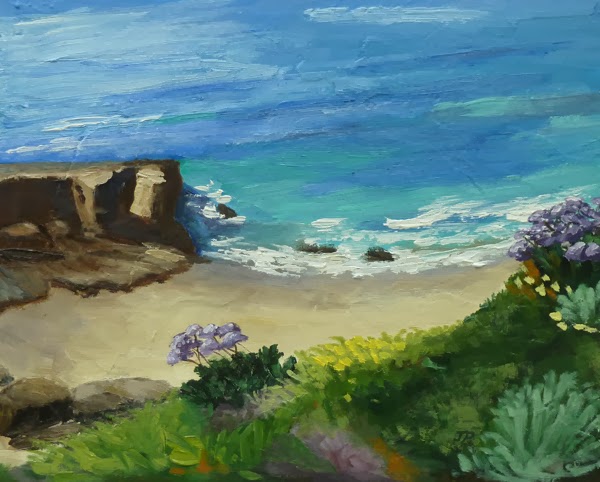The first thing I did was tape the drawing paper to a board. This gives me a solid surface to press upon and protects the paper from being damaged as it gets moved aside on my desk. As I start to work more on the drawing I will cover it, between sessions, with tracing paper as another layer of protection.
What I usually do is move it right away from my desk area so that my other desk-based activities don't impinge on it but that hasn't happened yet…
So far all I have done is colour in the black rocks. The black pencil I used is from Derwent's Drawing range. This pencil range is more like 'b' graphite pencils with a softer look and feel to them. I really like them but in tiny rocks like these, they leave too much white showing. So I went over it with another black from the Derwent Studio range. This range is more like 'h' graphite pencils which have more clay in them that the 'b's'.
This pencil filled in the small white areas without having to press very hard.
I don't like to press hard as doing so can warp the paper and will also damage the tooth of the paper.
The tooth is the texture of the paper which can be seen by lightly rubbing a pencil across the paper. The degree of tooth will vary between papers. Paper for office copier machines will have very little tooth compared with drawing papers. Some types of paper, like Bristol paper, come with a smoother finish (conveniently called smooth) and a more textured finish called vellum.
The paper you choose depends on the look you want. That also goes for the weight (or thickness) of paper you want. There is also a wide variety of weights available as well. See it explained here.
There are no rules, it all depends on what you discover you like.
The paper I am using came from a 22" x 30" sheet and is more or less card stock weight. Sorry I can't remember what the weight is (it doesn't say it on the label).
There is another piece of equipment that can damage the tooth of a paper - the eraser. By rubbing out your mistakes with a regular hard eraser (and doing so in a vigorous manner) you can destroy the paper's tooth, as well as risking scrunching the paper and damaging the whole drawing.
In this kind of drawing I use a kneaded eraser.
With a kneaded eraser you press it into the graphite or coloured pencil to remove it. A light touch is required and it takes longer to remove the pigment.
When you are learning and want to totally remove your marks then use cheaper paper and don't worry about the tooth. If you working on a nicer picture then use light marks with your pencil so it is easier to remove them.
One of the benefits of the kneaded eraser is the ability to shape it to help you erase tiny sections such as these small dots.
I always keep a regular eraser around just in case, and for coloured pencil pieces, I use a pencil sharpener that is only used with coloured pencils. This is an item I use a lot in my drawings. I like to keep my pencils very sharp throughout the process as I feel that I have more control when I have a shape point.
I personally like these manual pencil sharpeners. They are around $1.50 - $2. This one is a KUM and has one hole with a spare blade. I have others with two holes with one of the holes larger than the other for bigger pencils.
It is time to replace your sharpener when the blade starts hacking at the wood above the point.












